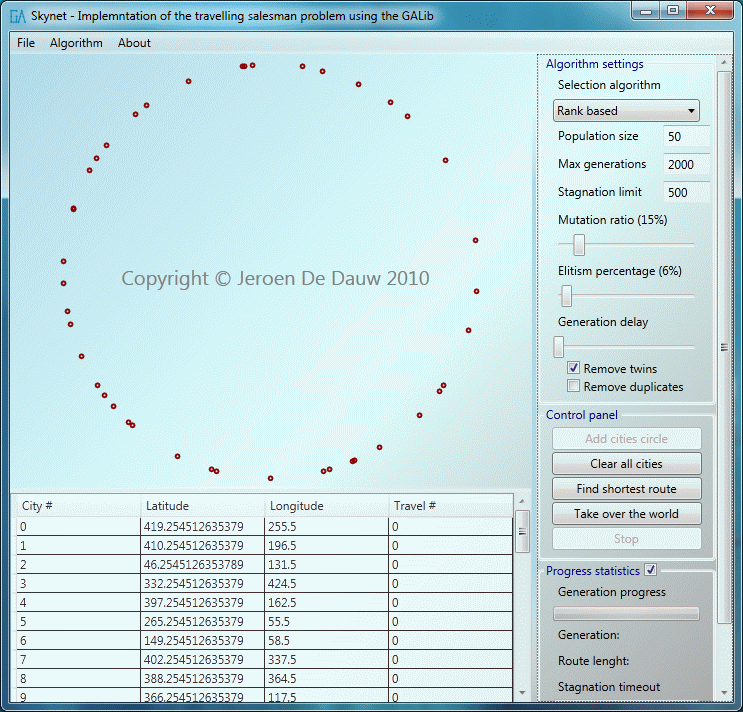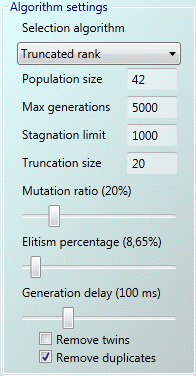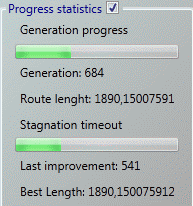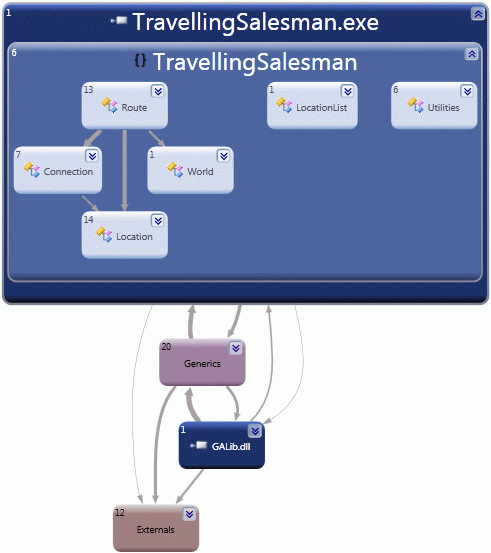
Jeroen De Dauw
Software Craftsman
Skynet
Skynet is an arterial intelligence hobby project I created in 2010. It solves the Travelling Salesman Problem (TSP) using Genetic Algorithms (GA). It is written in C#, has a Windows Presentation Foundation UI and is build upon my GALib genetic algorithm library. It's completely open source and available under the GNU General Public License.
Download
- Skynet0.1.7 setup.zip (includes installer and automatic updates)
- Executables tarball (latest version of the application executables)
- Source code tarball (latest version of the source code)
You can also download the project code directly via SVN from the SourceForge source code repository, at https://csgalib-tsp.svn.sourceforge.net/svnroot/csgalib-tsp. From a command line, you can call the following:
svn checkout https://csgalib-tsp.svn.sourceforge.net/svnroot/csgalib-tsp
Background
The idea for creating this application came to me after reading the first part of Bio-Inspired Artificial Intelligence by Dario Floreano and Claudio Mattiussi. I figured I needed to do an implementation of what I've read to test myself. I split up the general GA code from the application itself and created GALib, a small C# Library that provides the scaffolding for Genetic Algorithm based functionality. All work was done in my free time.

See this page for more screenshots.
Using the application
The application consists of 3 big regions; a canvas on which the graphics are drawn, a datagrid giving you a a more clean view of the data, and an menu on the right containing controls and statistics.
1. Adding cities
You can add cities by clicking any place on the canvas, which is the open space in the top left of the application, above the datagrid. A city is represented by a small red circle, and will also be added to the datagrid, where you can see it's coordinates. By selecting the city in the datagrid, the circle on the canvas will get highlighted.
If you don't want to bother putting a bunch of cities on the canvas, you can just click 'Add cities circle' in the control panel on the right. Doing so will add 42 cities arranged in a circle to the canvas and datagrid. By default, the application will already do this at startup.
To remove the current cities, click 'Clear all cities' in the control panel.
2. Configuring the settings
 All configuration is located in the 'Algorithm settings' box at the top right of the application.
All are pretty self explanatory, except maybe generation delay, which allows you to delay every
generation a certain amount of time. This is useful for debugging, and studying the first few steps
in detail.
All configuration is located in the 'Algorithm settings' box at the top right of the application.
All are pretty self explanatory, except maybe generation delay, which allows you to delay every
generation a certain amount of time. This is useful for debugging, and studying the first few steps
in detail.
3. Running the algorithm
You can run the application by hitting 'Find the shortest route' in the control panel on the right. You can also do this via the menu, by clicking Algorithm -> Start. To pause or resume the evolution, click their corresponding menu items in the Algorithm menu. To cancel the evolution, either click 'Stop' in the control panel, or again the menu item in the Algorithm menu. The algorithm will stop on itself when either the maximum amount of generations or the stagnation limit is reached.
Once the evolution is complete, you'll be shown a brief report in the form of a report window. The datagrid will also show the travel number of each city. By sorting on this number, you can easily highlight the cities in the route one by one, in the correct order.


4. Statistics
 You can view the current generation number and the length of the best route in it, as well as the
length of the overall best route and last improvement in the 'Progress statistics' panel in the bottom
right corner of the application. Two progress bars show the progress of the evolution (how many
generations of the maximum amount have been evolved), and stagnation time-out (how many generations
have gone without any improvement of the allowed amount).
You can view the current generation number and the length of the best route in it, as well as the
length of the overall best route and last improvement in the 'Progress statistics' panel in the bottom
right corner of the application. Two progress bars show the progress of the evolution (how many
generations of the maximum amount have been evolved), and stagnation time-out (how many generations
have gone without any improvement of the allowed amount).
How it works
This section explains how Skynet works as an implementation of GALib. If you are not familiar with how genetic algorithms work, you are advised to first have a good look at [this Wikipedia article] (https://en.wikipedia.org/wiki/Genetic_algorithm) and related pages. This section will introduce you to how GA logic specific to the TSP works in a bottom-up fashion. For more information on the actual evolution, see GALib.
Dependency diagram
For a full dependency diagram of both Skynet and GALib, see this image.

Location class
The Location class is a simple holder for locations, such as cities in the TSP. New instances are created by providing a Point. The class exposes the following properties: Latitude (Double), Longitude (Double), Id (Int32) and TravelNr (Int32). TravelNr is used to store a location's position in a Route.
Connection class
The Connection class consists out of 2 public fields of type Location, and is meant to represent the shortest connection between these two locations on a flat surface. You can get it's length via the read-only Length property.
Route class
The Route class, which contains the definition for the individuals that are getting evolved and is the core of the TSP implementation, inherits from Individual<Connection>. The genotype consists of a List<Connection>, which can be accessed via the public Connections property.
Points of Interest
Since my main motivation for creating this application was exercise, I learned a lot from building it. It's my first decent C# application, as well as the first time I've created one using WPF and the first time I've done any GA programming (or AI in general). It also gave me the chance to familiarize myself with some of the new things of .Net 4.0, some profiling tools, and have some fun with navigation based windows. The biggest challenge in the application itself (so not counting GALib), was definitely creating the crossover algorithm for the Route individual type. At first I simply took half of the connections of one parent, and then the other half from the other parent, but I rewrote this to take all common connections. Although the crossover algorithm works fine now, it's pretty heavy on the cpu, and limiting the maximum speed of the application severely. If anyone finds a way to speed it up, be sure to let me know :)